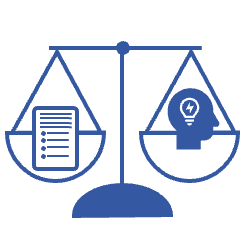How can I develop exams that help me fairly assess student learning?

These are quick tips from the Faculty Teaching Institute for using summative assessments (primarily exams and quizzes) in ways that will assess what you value in student learning while being compassionate, clear, and fair and facilitating student learning. See also the Constellation of Summative Assessment Techniques.
Align with student learning outcomes (SLOs) and homework. Review SLOs when creating quizzes and exams to ensure that exams are targeting what you value. Make sure the homework questions are similar to exam questions so that students are prepared to do well and feel the exam is fair. Typical test questions can be valuable to include on homework.
Consider alternative forms of summative assessment. While exams are common mainstays of summative assessment, review the “universe of summative assessments” for more creative approaches such as projects and presentations.
Don’t make exams too long. Make sure the slowest student will have time to finish. Some instructors make exams take-home to eliminate time limits. If in class, a rule of thumb is one minute per multiple-choice item, two minutes per short answer, and 15-30 minutes for a problem or essay.
Do your exam yourself, and show it to a colleague to make sure it’s clear, reasonable, and readable. Review for jargon, ensure sentences are short, use clear prompts, and highlight key parts in bold.
Tell students the content and format of exam questions in advance so that they can prepare well and reduce anxiety. Provide old exams and (possibly) practice exams.
Consider two-stage or group exams where students complete the exam individually, and then again in a group. The group score adds incrementally to their individual score, providing an incentive to work productively. This technique provides built-in accountability and learning from the exam results. Many sources online describe this in detail.
Use a mix of questions. Different questions will assess different learning outcomes, such as conceptual understanding, problem-solving, or other skills. Make sure the exam is testing what you want them to know. Higher-level learning outcomes will require some essay questions or problem-solving, which will take more time to grade. Some common exam question types:
- Problems
- Short answer
- Essays
- True false (paired with explanation)
- Multiple choice
- Matching
- Sketching
- Graphing
Most physics exams include some problem-solving. Since these can be time-consuming to complete and to grade, consider having students set up the problem but not complete it. Good multiple-choice questions are hard to write; review online sources on how to write good questions.
Debrief with students after the exam so that they understand how their performance relates to that of other students and make sure that a low score on the exam does not discourage certain people (especially from historically marginalized groups). This is also a time to transparently share any mistakes you made in designing the exam and how you will manage that error.
Give students some feedback, including encouragement. Giving students feedback is important, but that feedback should be actionable and brief (see “homework practices”), especially since students will pay less attention to that feedback when it is accompanied by a grade. The most important thing to do on the quiz or exam is to add the personal touch of encouragement or praise since this is often one of the few times an instructor has the opportunity to add a personal touch.
Have students complete an “exam wrapper” as an assignment after the exam. An exam wrapper asks students to reflect on their performance on the exam, possibly identify where their solution went wrong, and identify changes they might make to their study strategy in the future. There are many examples online.
Additional practices:
- Post solutions. Post solutions and hold students accountable for reviewing where their work did or didn’t follow the solution, and allow them to submit a revision.
- Make notes for yourself in your teaching journal or other reflective notes so you improve your exams over time.
This Expert Recommendation is based in part on W. McKeachie & M. Svinicki, McKeachie’s Teaching Tips (Cengage Learning, 2014) and R. Felder & R. Brent, Teaching and learning STEM (Jossey-Bass, 2016).
This material is based upon work supported by the National Science Foundation under grants DUE-2141678, 2141745, 2141769, 2141795, and 2142045. Any opinions, findings, and conclusions or recommendations expressed in this material are those of the author(s) and do not necessarily reflect the views of the National Science Foundation.
 Add a Comment
Add a Comment


